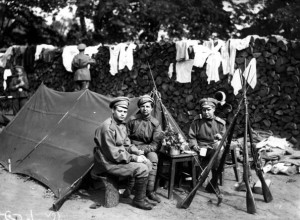
1917: Women from a Russian 'death battalion', a tough women's unit, sit outside their tent. (Photo by Slava Katamidze Collection/Getty Images)
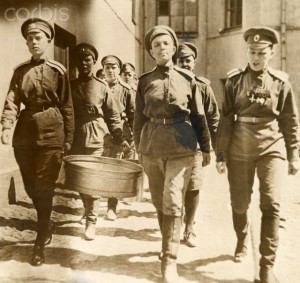
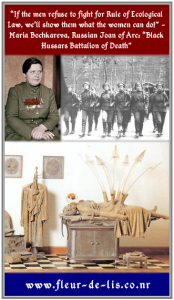
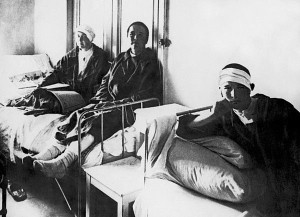
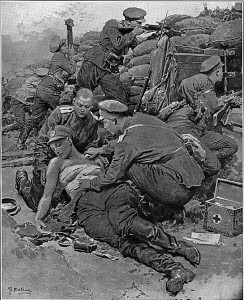
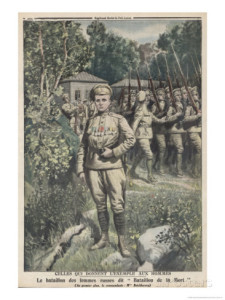
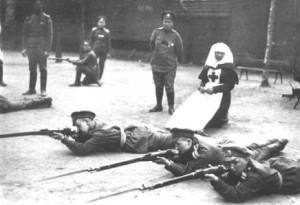

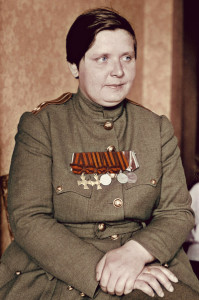
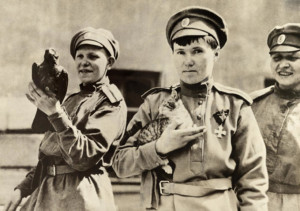
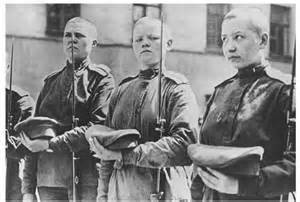
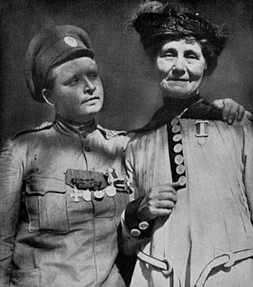 Exciting new photos and facts regarding the Women's Battalion of Death which fought the Germans in WW I and later fought with the Kerensky Brigade for the Provisional Government. Led by Maria Bochkareva- who was personally appointed by the Tsar Nicholas II. The most startling battle in 1917 showed this female force charging forward while the male troops, discovering a cache of vodka, fell down and DRANK themsemselves into a stupor. Maria Bochkareva - a former peasant girl -- suffered greatly and actually been forced into a brothel- only to emerge, marry twice and divorce twice- the last to a kosher butcher named Buk-She went on to fight and be severely wounded several times.
Bochkareva joined the 25th Tomsk Reserve Battalion of the Imperial Russian Army by securing the personal permission of Nicholas II. Men of the regiment ridiculed and sexually harassed her until she proved her mettle in battle. Maria Bochkareva was twice wounded and decorated three times for bravery. She bayoneted at least one German soldier to death.
After the abdication of the Tsar in March 1917, she was charged with creating an all-female combat unit by Alexander Kerensky, then Minister of War. This was Bochkareva's 1st Russian Women's Battalion of Death and initially attracted around 2,000 women volunteers, but the commander's strict discipline drove all but around 300 dedicated women soldiers out of the unit.
After a month of intensive training, Bochkareva and her unit were sent to the Russian western front to participate in the Kerensky Offensive. The unit was involved in one major battle,teh battle of Smarthon.The women of the unit performed well in combat, but the vast majority of male soldiers, collapsed and drank the cache of vodka. Bochkareva was badly wounded and sent back to Petrograd to recuperate.
Bochkareva was only marginally involved in the creation of other women's combat units formed in Russia during the spring and summer of 1917. Her unit was at the front at the time of the Bolshevik October Revolution and did not participate in the defense of the Winter Palace. (That was left to another women's unit, the 1st Petrograd Women's Battalion). The unit disbanded after facing increasing hostility from the male troops remaining at the front. Bochkareva was initially detained by the Bolsheviks but released shortly thereafter. She secured permission to rejoin her family inTomsk but left for Petrograd again in early 1918. She claims to have then received a telegram asking her to take a message to the famous Cossack General Lavr Kornilov, who was commanding the White Army in the Caucasus. After leaving Kornilov's headquarters, she was again seized by Bolsheviks, and because of her connection with the Whites, wasto be executed. She was spared, however, by a soldier who had served with her in the Imperial army in 1915 and who convinced the Bolsheviks to stay her execution. She was granted an external passport and allowed to leave the country. Bochkareva then made her way to the United States by steamship in April, 1918.
Bochkareva made her way to New York and then to Washington D.C. She was sponsored by the wealthy socialite/suffragette Florence "Daisy" Harriman. Bochkareva was given a meeting with President Woodrow Wilson on July 10, 1918, during which she begged the president to intervene in Russia. Wilson was apparently so moved by her emotional appeal that he responded with tears in his eyes and promised to do what he could.
While in New York, Bochkareva dictated her memoirs, Yashka: My Life As Peasant, Exile, and Soldier to a Russian emigre journalist named Isaac Don Levin (his interview is featured in the Diane Keaton/Warren Beatty film REDS. After leaving the United States she traveled to Great Britain where she was granted an audience with the King of England, George V, Nicholas II's cousin and lookalike. The British War Office gave her funding to return to Russia. This was a tragic mistake, as she was soon seized bythe Bolsheviks again and tried and found guilty as "an enemy of the people" and shot to death by a Cheka firing squad on May 16, 1920. She was 31 years old.
Exciting new photos and facts regarding the Women's Battalion of Death which fought the Germans in WW I and later fought with the Kerensky Brigade for the Provisional Government. Led by Maria Bochkareva- who was personally appointed by the Tsar Nicholas II. The most startling battle in 1917 showed this female force charging forward while the male troops, discovering a cache of vodka, fell down and DRANK themsemselves into a stupor. Maria Bochkareva - a former peasant girl -- suffered greatly and actually been forced into a brothel- only to emerge, marry twice and divorce twice- the last to a kosher butcher named Buk-She went on to fight and be severely wounded several times.
Bochkareva joined the 25th Tomsk Reserve Battalion of the Imperial Russian Army by securing the personal permission of Nicholas II. Men of the regiment ridiculed and sexually harassed her until she proved her mettle in battle. Maria Bochkareva was twice wounded and decorated three times for bravery. She bayoneted at least one German soldier to death.
After the abdication of the Tsar in March 1917, she was charged with creating an all-female combat unit by Alexander Kerensky, then Minister of War. This was Bochkareva's 1st Russian Women's Battalion of Death and initially attracted around 2,000 women volunteers, but the commander's strict discipline drove all but around 300 dedicated women soldiers out of the unit.
After a month of intensive training, Bochkareva and her unit were sent to the Russian western front to participate in the Kerensky Offensive. The unit was involved in one major battle,teh battle of Smarthon.The women of the unit performed well in combat, but the vast majority of male soldiers, collapsed and drank the cache of vodka. Bochkareva was badly wounded and sent back to Petrograd to recuperate.
Bochkareva was only marginally involved in the creation of other women's combat units formed in Russia during the spring and summer of 1917. Her unit was at the front at the time of the Bolshevik October Revolution and did not participate in the defense of the Winter Palace. (That was left to another women's unit, the 1st Petrograd Women's Battalion). The unit disbanded after facing increasing hostility from the male troops remaining at the front. Bochkareva was initially detained by the Bolsheviks but released shortly thereafter. She secured permission to rejoin her family inTomsk but left for Petrograd again in early 1918. She claims to have then received a telegram asking her to take a message to the famous Cossack General Lavr Kornilov, who was commanding the White Army in the Caucasus. After leaving Kornilov's headquarters, she was again seized by Bolsheviks, and because of her connection with the Whites, wasto be executed. She was spared, however, by a soldier who had served with her in the Imperial army in 1915 and who convinced the Bolsheviks to stay her execution. She was granted an external passport and allowed to leave the country. Bochkareva then made her way to the United States by steamship in April, 1918.
Bochkareva made her way to New York and then to Washington D.C. She was sponsored by the wealthy socialite/suffragette Florence "Daisy" Harriman. Bochkareva was given a meeting with President Woodrow Wilson on July 10, 1918, during which she begged the president to intervene in Russia. Wilson was apparently so moved by her emotional appeal that he responded with tears in his eyes and promised to do what he could.
While in New York, Bochkareva dictated her memoirs, Yashka: My Life As Peasant, Exile, and Soldier to a Russian emigre journalist named Isaac Don Levin (his interview is featured in the Diane Keaton/Warren Beatty film REDS. After leaving the United States she traveled to Great Britain where she was granted an audience with the King of England, George V, Nicholas II's cousin and lookalike. The British War Office gave her funding to return to Russia. This was a tragic mistake, as she was soon seized bythe Bolsheviks again and tried and found guilty as "an enemy of the people" and shot to death by a Cheka firing squad on May 16, 1920. She was 31 years old.
